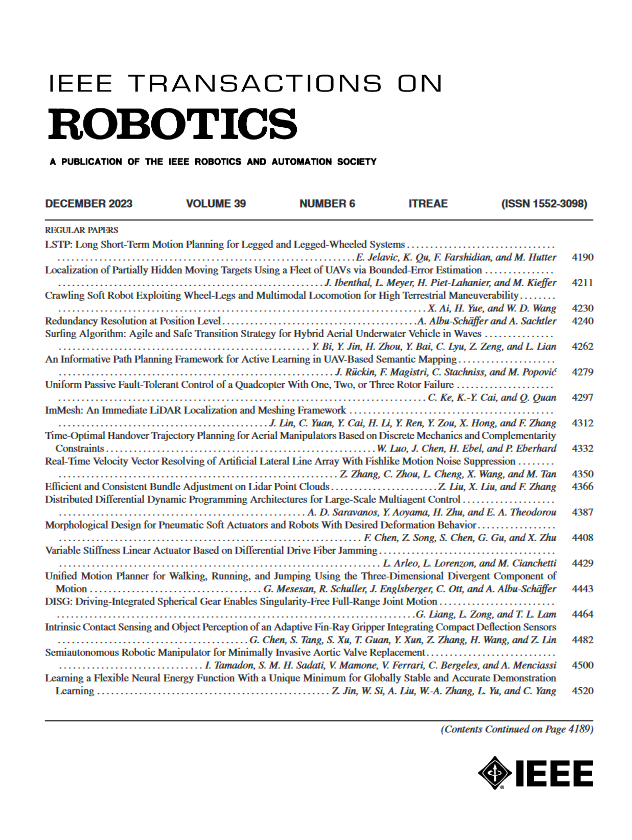混合现实双边人体遥操作的稳定性和透明性
IF 10.5
1区 计算机科学
Q1 ROBOTICS
引用次数: 0
摘要
最近的工作介绍了人类远程操作(HT)的概念,其中在传统的双边远程操作中通常考虑的远程机器人被一个戴着混合现实头戴式显示器并跟踪由专家控制的虚拟工具运动的新手所取代。在低资源社区或偏远地区,HT在成本、复杂性和患者接受远程医疗方面具有优势。然而,双侧HT的稳定性、透明度和性能尚未得到探讨。因此,在本文中,我们利用测试数据建立了高温系统的数学模型。然后,我们用该模型分析了各种控制架构,并将其与HT系统一起实施,测试志愿者操作员和基于虚拟夹具的模拟患者,以找到可实现的性能,研究稳定性,并确定在存在时间延迟的情况下最有前途的远程操作方案。我们表明,HT的不稳定性,虽然不是破坏性的或危险的,但使系统无法使用。然而,对于新手来说,通过三通道遥操作可以实现小时间延迟($< \text{200}$ ms)的稳定和透明的遥操作,或者通过具有局部姿态和力反馈的模型介导遥操作实现大时间延迟。本文章由计算机程序翻译,如有差异,请以英文原文为准。
Stability and Transparency in Mixed-Reality Bilateral Human Teleoperation
Recent work introduced the concept of human teleoperation (HT), where the remote robot typically considered in conventional bilateral teleoperation is replaced by a novice person wearing a mixed-reality head-mounted display and tracking the motion of a virtual tool controlled by an expert. HT has advantages in cost, complexity, and patient acceptance for telemedicine in low-resource communities or remote locations. However, the stability, transparency, and performance of bilateral HT are unexplored. In this article, we, therefore, develop a mathematical model of the HT system using test data. We then analyze various control architectures with this model and implement them with the HT system, testing volunteer operators and a virtual fixture-based simulated patient to find the achievable performance, investigate stability, and determine the most promising teleoperation scheme in the presence of time delays. We show that instability in HT, while not destructive or dangerous, makes the system impossible to use. However, stable and transparent teleoperation is possible with small time delays ($< \text{200}$
求助全文
通过发布文献求助,成功后即可免费获取论文全文。
去求助
来源期刊

IEEE Transactions on Robotics
工程技术-机器人学
CiteScore
14.90
自引率
5.10%
发文量
259
审稿时长
6.0 months
期刊介绍:
The IEEE Transactions on Robotics (T-RO) is dedicated to publishing fundamental papers covering all facets of robotics, drawing on interdisciplinary approaches from computer science, control systems, electrical engineering, mathematics, mechanical engineering, and beyond. From industrial applications to service and personal assistants, surgical operations to space, underwater, and remote exploration, robots and intelligent machines play pivotal roles across various domains, including entertainment, safety, search and rescue, military applications, agriculture, and intelligent vehicles.
Special emphasis is placed on intelligent machines and systems designed for unstructured environments, where a significant portion of the environment remains unknown and beyond direct sensing or control.
 求助内容:
求助内容: 应助结果提醒方式:
应助结果提醒方式:


